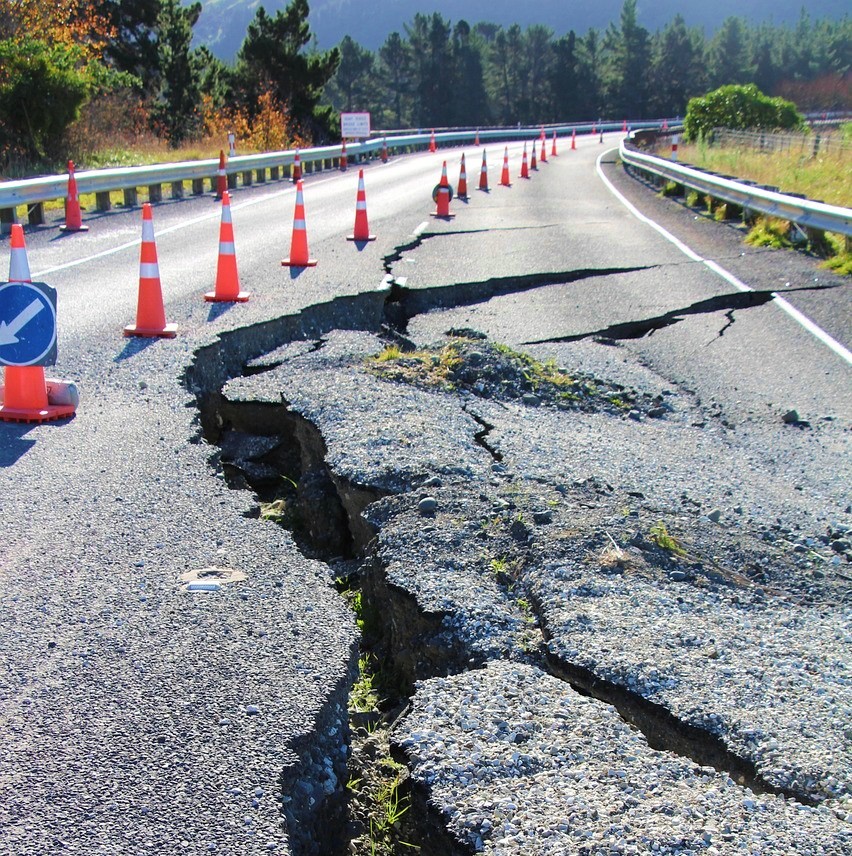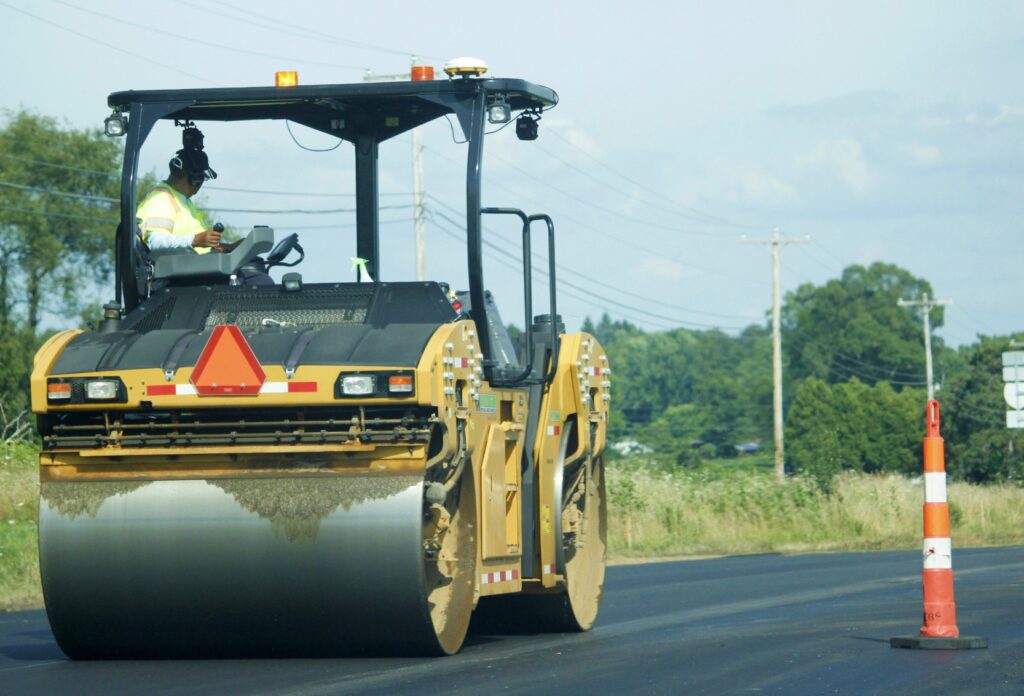A professionally laid and sealed road surface generally lasts for around 25 years.
You might go more than a decade without seeing a single crack, depression or fleck of loose aggregate.
But once deterioration begins, it happens exponentially quickly.
Ignoring early signs of a failing road surface can mean costly repairs later on. Uneven cambers or potholes in the road surface also create trip hazards and skid risks, which can lead to accidents.
Thankfully, you can solve these risks before they even arise with timely road resurfacing and repair.
By addressing signs your road needs resurfacing, you can extend the lifespan of your road infrastructure, prevent accidents and avoid spiralling costs of emergency repair or full reconstruction.
So look out for these top 5 road repair signs to make sure you can carry out effective road surface maintenance.
Cracking is one of the earliest road repair signs. It indicates a weakening structure in need of road resurfacing.
There are different types of road surface cracks, each with their own causes:
Surface cracks are more than just cosmetic flaws.
They’re early asphalt damage indicators that allow water to penetrate the surface, weakening the base and speeding up deterioration.
Over time, small cracks widen and join together, leading to potholes and surface collapse.
Surface sealing, patching or road resurfacing prevents further damage, improving safety and reducing your long-term maintenance costs.
Where cracks are early signs a road needs resurfacing, potholes occur when the surface has already suffered significant breakdown.
They start forming when water penetrates through cracks or other worn patches.
In colder conditions, trapped water freezes and expands, widening the gaps in the road surface.
And when the temperature rises, the water contracts, leaving greater voids beneath it.
The repeated weight and vibrations of vehicle traffic then force the weakened material out, forming a shallow depression.
Without proper highway maintenance services, minor defects quickly become large and dangerous potholes.
Constant stress leads to even more cracking or crumbling tarmac, causing the pothole to grow.
And when multiple holes connect together, the wider surface can collapse.
This increases the risk of accidents and damage to vehicles. And it could even result in legal action.
On commercial or high-traffic roads, extensive potholing can interrupt deliveries, deter customers and harm public image.
Repairs then escalate from simple minor works to full road resurfacing, draining your funds and disrupting operations.
Targeted patching or micro asphalt repair can address small potholes before they grow.
That means you can keep commercial road maintenance works small, and therefore quicker and more cost effective.
Water that lingers for longer than usual after rainfall indicates that your drainage system isn’t working as intended.
Roads are designed with a slight camber or slope to direct rainwater away.
So when pooling occurs, it’s a clear sign that those drainage routes are blocked or the underlying surface has shifted.
Standing water also suggests that liquid is seeping into the sublayer. This puts it at risk of deterioration from freeze-thaw cycles.
And if there’s a problem with your foundations, the only solution is full road replacement – much more expensive than resurfacing or repair!
Slow-draining gullies, collapsed drains, sunken patches and blocked or damaged drainage channels are common road repair signs that show your drainage systems aren’t working properly.
If you don’t take action, relatively simple repair works won’t be enough to solve the issue.
These aren’t the kinds of problems you can solve yourself, though. So it’s important to get in touch with a trusted road resurfacing contractor to put things right.
The team at Hazell & Jefferies Ltd will identify the main causes of your drainage issues. And we’ll perform road resurfacing, sealing or repairs as necessary to restore performance.
With our help, you can extend the lifespan of your roads and protect road users against accidents and property damage.
Traffic wear, UV exposure and weathering all contribute to surface dressing deterioration over time.
This weakens the binder that holds aggregates in place, allowing stones to come loose.
If they’re not replaced, water can pool in the uneven spaces and penetrate through to the sublayer.
And when that water freezes and thaws, it pushes the road surface material apart, causing major damage that’s both difficult and expensive to fix.
Fading lines or missing markers are also notable asphalt damage indicators.
That’s because they show that the surface coating has thinned to the point where it can’t retain paint effectively.
These problems might seem cosmetic. But when left to grow, they can lead to much deeper damage.
As aggregates loosen and surface texture wears away, skid resistance also declines.
That means greater stopping distances and an increased risk of accidents, especially in wet or icy conditions.
Faded markings also make the road look neglected, which can affect public perception.
But they can also violate compliance with road safety standards, which might lead to legal action.
Small works like micro asphalt, surface dressing or resealing restore the safety and visual appeal of your road surface.
And by protecting against further damage, they also help you keep long-term maintenance costs down.
Warped and damaged road surfaces often speak to underlying problems in the subsurface, such as eroded base layers, poor drainage and soil movement.
Heavy and repeated traffic loads, especially from commercial vehicles, cause further stress on the road surface, creating permanent indentations.
And as water collects in these, freeze-thaw cycles accelerate the surface damage and lead to further weakening of the road structure.
If ignored, the damage extends beyond cosmetic defects and threatens the road’s structural integrity, often necessitating full road replacement.
For commercial roads, uneven surfaces and ruts present operational challenges.
They slow traffic, cause vehicle damage and increase the risk of accidents, especially for heavy trucks and delivery vehicles.
These disruptions affect supply chains and customer access, which in turn impact business efficiency and reputation.
In residential areas, depressions and bumps reduce comfort and accessibility.
And they raise the risk of accidents for motorists, cyclists and even pedestrians.
Uneven road surfaces are also liability concerns for property owners or estate managers responsible for maintenance.
Carrying out prompt repairs and regular commercial road maintenance ensures smooth, safe access and protects your infrastructure investments.
Being able to spot asphalt damage indicators and signs a road needs resurfacing is crucial to effective and affordable long-term road maintenance.
But even if you know what to look for, it’s unlikely you can fix these problems yourself.
So it’s also essential to partner with a trusted road surfacing contractor to ensure the best care for your road surfaces.
Hazell & Jefferies Ltd can inspect, diagnose and quote for any road resurfacing and repairs throughout Oxfordshire, Berkshire, Reading and the surrounding areas.
We can even take on projects elsewhere in the UK on request!
Our team has more than 50 years of experience in commercial, civil and residential road resurfacing and repair.
We’re certified under British Standards Quality Assurance ISO 9001:2015. And we carry public liability insurance up to £10m to give you total peace of mind.
Contact us today for your free quote!
You probably need road resurfacing or repair if you spot:
These all suggest your surface is losing durability, which can also compromise safety.
You should replace an asphalt road every 15-25 years depending on usage, weather exposure, drainage quality and ongoing maintenance.
Regular inspections help determine if resurfacing, patching or complete replacement is the best option.
Of course. Early-stage damage like small cracks, fading or loose aggregates can be sealed, filled or repaired quickly.
These proactive road maintenance techniques extend the life of your road surface without the need for costly replacements – provided the underlying structure is still in good shape.
The property owner, estate management company or residents’ association are usually responsible for private road resurfacing.
Unlike public roads, private estate roads must be maintained and resurfaced at the owners’ expense.

